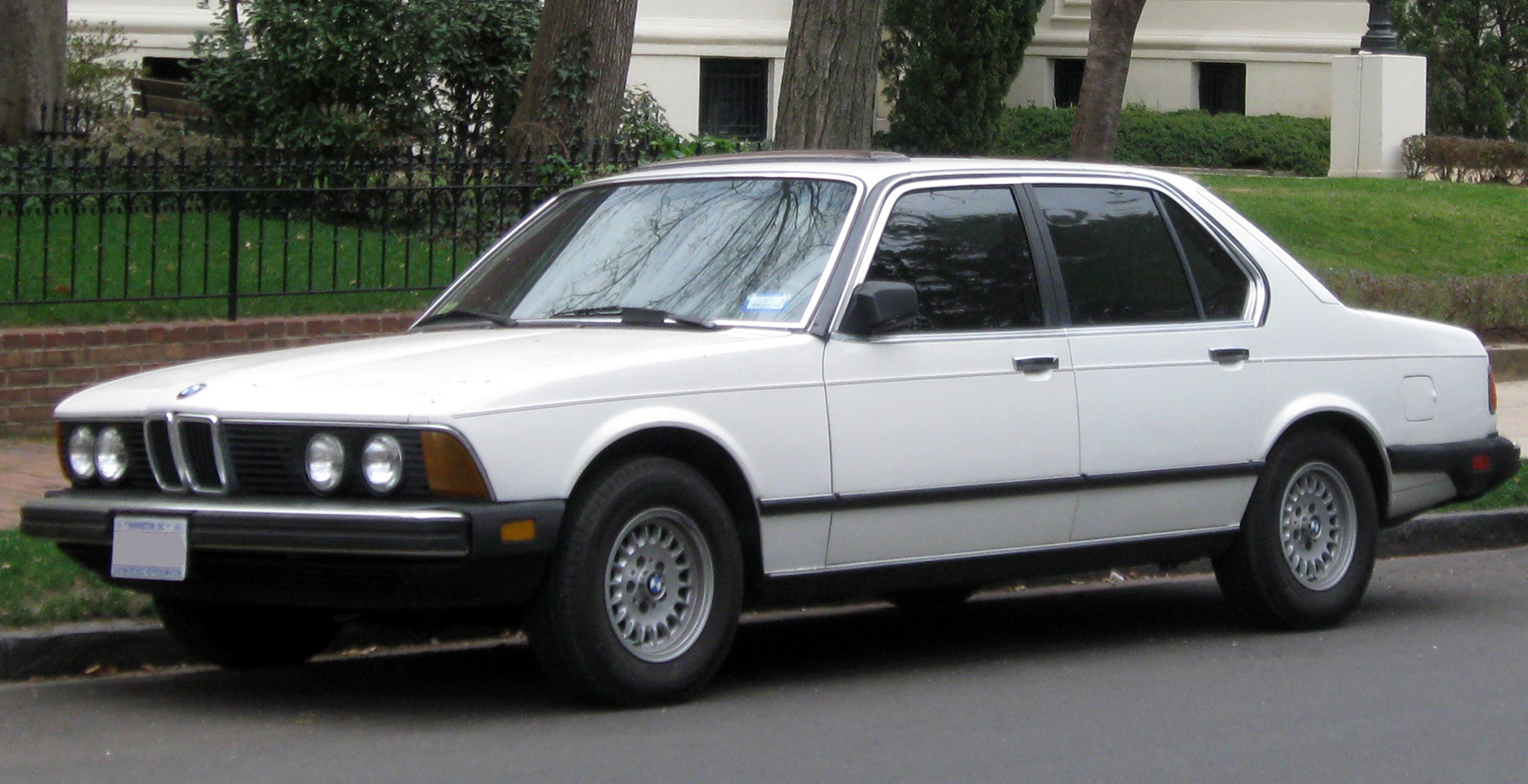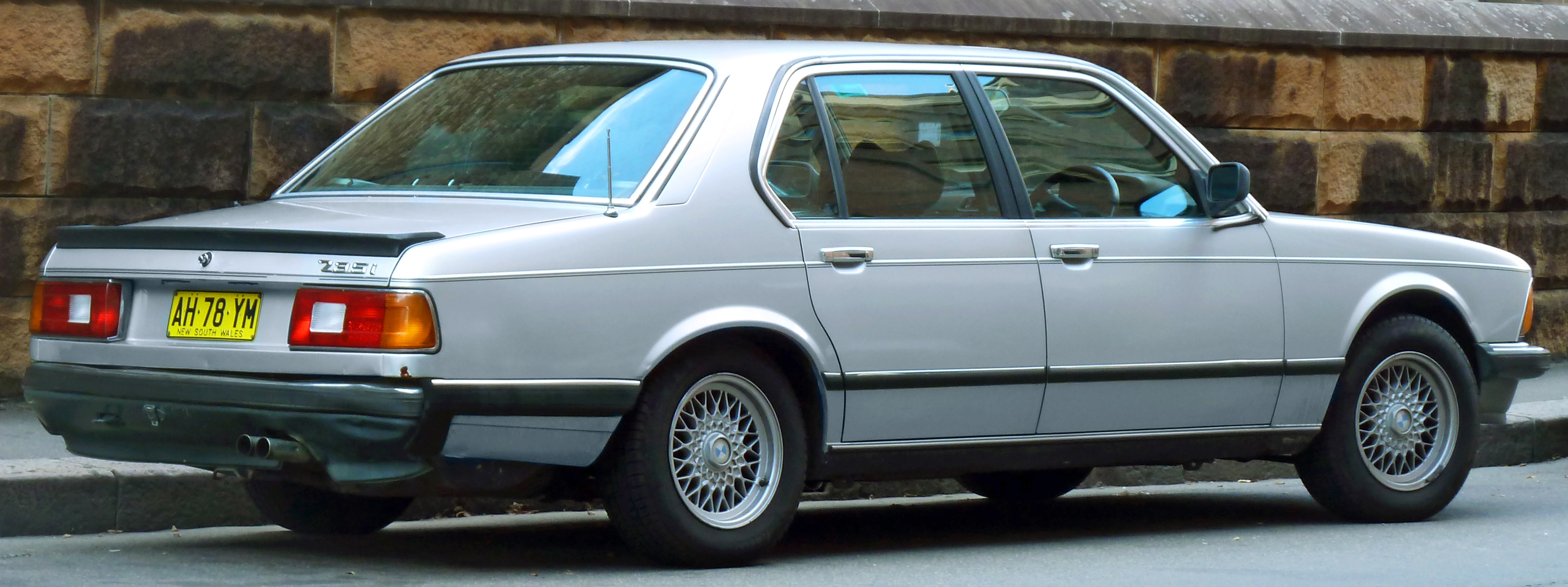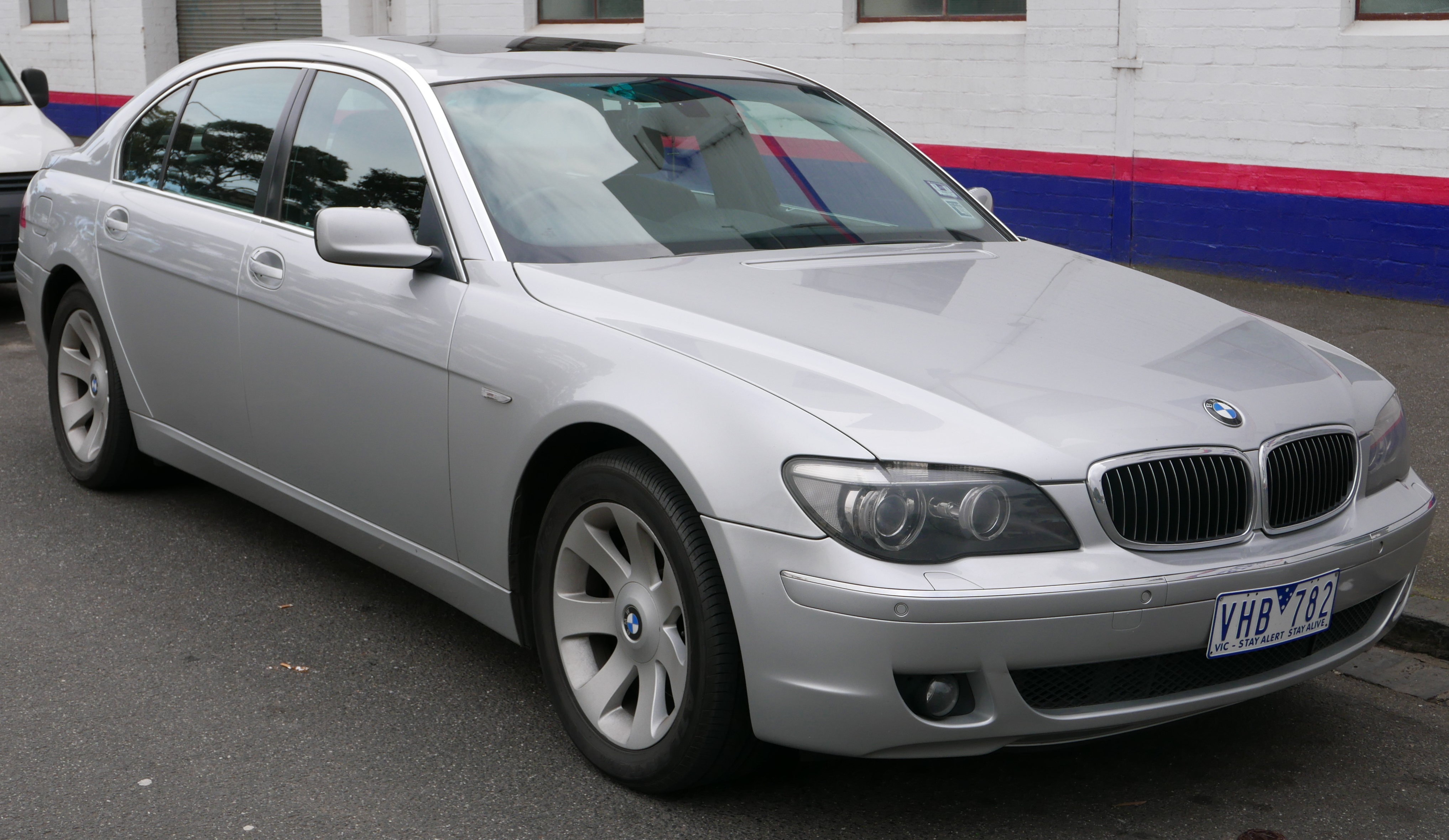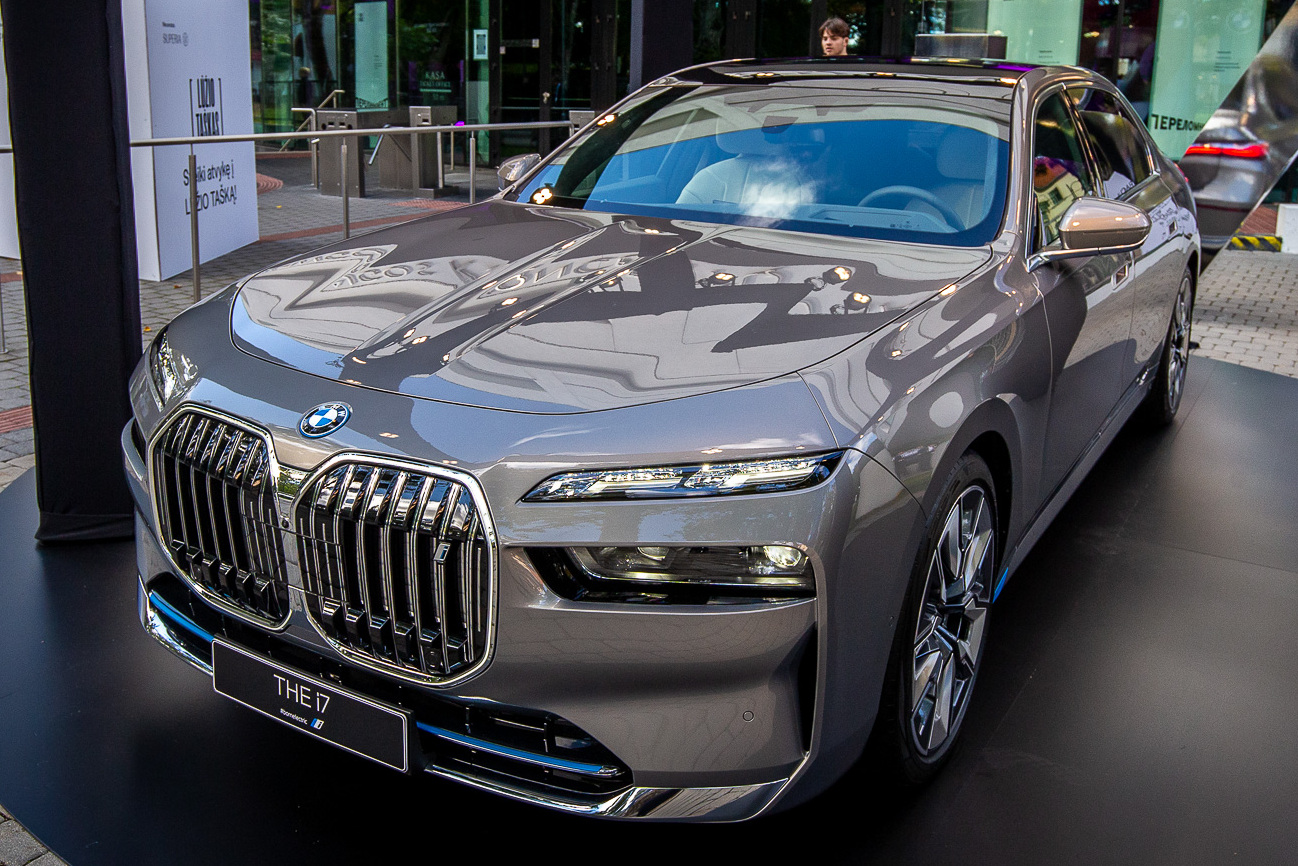BMW 7-Series on:
[Wikipedia]
[Google]
[Amazon]
The BMW 7 Series is a

 The E23 is the first generation 7 Series and was produced from 1977 to 1987. It was built in a 4-door sedan body style with 6-cylinder engines, to replace the E3 sedans. From 1983 to 1987, a turbocharged 6-cylinder engine was available.
The E23 introduced many electronic features for the first time in a BMW, including an onboard computer, a service interval indicator, a "check control panel" (warning lights to indicate system faults to the driver), a dictaphone, and complex climate control systems. It was also the first BMW to offer an anti-lock braking system (ABS), a driver's airbag, and double-link front suspension.
The E23 is the first generation 7 Series and was produced from 1977 to 1987. It was built in a 4-door sedan body style with 6-cylinder engines, to replace the E3 sedans. From 1983 to 1987, a turbocharged 6-cylinder engine was available.
The E23 introduced many electronic features for the first time in a BMW, including an onboard computer, a service interval indicator, a "check control panel" (warning lights to indicate system faults to the driver), a dictaphone, and complex climate control systems. It was also the first BMW to offer an anti-lock braking system (ABS), a driver's airbag, and double-link front suspension.

 The E32 is the second generation of the 7 Series, which was produced from 1986 to 1994. It was initially available with a
The E32 is the second generation of the 7 Series, which was produced from 1986 to 1994. It was initially available with a

 The E38 is the third generation of the 7 Series, which was produced from 1994 to 2001. The model range consisted of standard length and long wheelbase ("iL" models) sedans.
The petrol engines available consisted of
The E38 is the third generation of the 7 Series, which was produced from 1994 to 2001. The model range consisted of standard length and long wheelbase ("iL" models) sedans.
The petrol engines available consisted of

 The E65/E66/E67/E68 is the fourth generation 7 Series, which was produced from 2001 to 2008. The model range consisted of standard length and long wheelbase ("Li" models) sedans.
The E65/E66/E67/E68 was the first BMW to include iDrive, "flame-surfacing" exterior styling, active anti-roll bars, a 6-speed automatic transmission, an electronic
The E65/E66/E67/E68 is the fourth generation 7 Series, which was produced from 2001 to 2008. The model range consisted of standard length and long wheelbase ("Li" models) sedans.
The E65/E66/E67/E68 was the first BMW to include iDrive, "flame-surfacing" exterior styling, active anti-roll bars, a 6-speed automatic transmission, an electronic

 The G11/G12 is the sixth generation of the 7 Series, which has been in production since 2015. It was revealed on June 10, 2015, at BMW's headquarters in Munich. An official public reveal took place at the 2015 International Motor Show Germany.
G11 is the codename for the short-wheelbase model, the extended-wheelbase model is codenamed G12 and designated with an additional ''L'' letter.
The G11/G12 is the first car lineup of the BMW Group to be based on the modular OKL platform (Oberklasse, German for luxury class). The OKL platform adopts technology first introduced in
The G11/G12 is the sixth generation of the 7 Series, which has been in production since 2015. It was revealed on June 10, 2015, at BMW's headquarters in Munich. An official public reveal took place at the 2015 International Motor Show Germany.
G11 is the codename for the short-wheelbase model, the extended-wheelbase model is codenamed G12 and designated with an additional ''L'' letter.
The G11/G12 is the first car lineup of the BMW Group to be based on the modular OKL platform (Oberklasse, German for luxury class). The OKL platform adopts technology first introduced in
 The BMW 7 Series debuted in April 2022. It has an electric variant, the BMW i7, along with 6-cylinder 740i and V8 760i models. It adopts horizontally split headlight units featured on the X7 LCI which was also launched in April 2022. Engine options remain similar with 3.0-litre 6-cylinder and 4.4-litre V8 options but no V12 engines will be offered.
The BMW 7 Series debuted in April 2022. It has an electric variant, the BMW i7, along with 6-cylinder 740i and V8 760i models. It adopts horizontally split headlight units featured on the X7 LCI which was also launched in April 2022. Engine options remain similar with 3.0-litre 6-cylinder and 4.4-litre V8 options but no V12 engines will be offered.
full-size
Full-size car—also known as large car—is a vehicle size class which originated in the United States and is used for cars larger than mid-size cars, it is the largest size class for cars. In Europe, it is known as E-segment or F-segment.
Af ...
luxury sedan
A luxury car is a car that provides increased levels of comfort, equipment, amenities, quality, performance, and associated status compared to moderately priced cars.
The term is subjective and reflects both the qualities of the car and the b ...
manufactured and marketed by the German automaker BMW since 1977. It is the successor to the BMW E3 "New Six" sedan and is now in its seventh generation.
The 7 Series is BMW's flagship car
A flagship is a vessel used by the commanding officer of a group of naval ships, characteristically a flag officer entitled by custom to fly a distinguishing flag. Used more loosely, it is the lead ship in a fleet of vessels, typically the fi ...
and is only available in a sedan bodystyle (including long wheelbase and limousine
A limousine ( or ), or limo () for short, is a large, chauffeur-driven luxury vehicle with a partition between the driver compartment and the passenger compartment.
A very long wheelbase luxury sedan (with more than four doors) driven by a prof ...
models). It traditionally introduces technologies and exterior design themes before other models in BMW's lineup.
The first generation of the 7 Series was powered by straight-6
The straight-six engine (also referred to as an inline-six engine; abbreviated I6 or L6) is a piston engine with six cylinders arranged in a straight line along the crankshaft. A straight-six engine has perfect primary and secondary engine bal ...
petrol engines, and following generations have been powered by inline-4
A straight-four engine (also called an inline-four) is a four-cylinder piston engine where cylinders are arranged in a line along a common crankshaft.
The vast majority of automotive four-cylinder engines use a straight-four layout (with the ...
, straight-6
The straight-six engine (also referred to as an inline-six engine; abbreviated I6 or L6) is a piston engine with six cylinders arranged in a straight line along the crankshaft. A straight-six engine has perfect primary and secondary engine bal ...
, V8 and V12 V12 or V-12 may refer to:
Aircraft
* Mil V-12, a Soviet heavy lift helicopter
* Pilatus OV-12, a planned American military utility aircraft
* Rockwell XFV-12, an American experimental aircraft project
* Škoda-Kauba V12, a Czechoslovak experim ...
engines with both natural aspiration
Nature, in the broadest sense, is the physical world or universe. "Nature" can refer to the phenomena of the physical world, and also to life in general. The study of nature is a large, if not the only, part of science. Although humans are ...
and turbocharging
In an internal combustion engine, a turbocharger (often called a turbo) is a forced induction device that is powered by the flow of exhaust gases. It uses this energy to compress the intake gas, forcing more air into the engine in order to pro ...
. Since 1995, diesel engines have been optional in the 7 Series.
Unlike the 3 Series and 5 Series sedans, BMW has offered a nonpureblood M variant, the BMW M760 6.6L V12 (at the time the most powerful BMW ever made, not to be confused with BMW 760 6.6 V12 which does not offer the same performance). The Alpina B7 (G12)
The Alpina B7 Bi-Turbo, or Alpina B7, is the fifth generation of the high performance full-size luxury car manufactured by German automobile manufacturer Alpina. Based on the BMW 7 Series (G12), the B7 Bi-Turbo was introduced at the 2016 Geneva ...
serves as one of the high-performance variants of the 7 Series.
First generation (E23; 1977)

 The E23 is the first generation 7 Series and was produced from 1977 to 1987. It was built in a 4-door sedan body style with 6-cylinder engines, to replace the E3 sedans. From 1983 to 1987, a turbocharged 6-cylinder engine was available.
The E23 introduced many electronic features for the first time in a BMW, including an onboard computer, a service interval indicator, a "check control panel" (warning lights to indicate system faults to the driver), a dictaphone, and complex climate control systems. It was also the first BMW to offer an anti-lock braking system (ABS), a driver's airbag, and double-link front suspension.
The E23 is the first generation 7 Series and was produced from 1977 to 1987. It was built in a 4-door sedan body style with 6-cylinder engines, to replace the E3 sedans. From 1983 to 1987, a turbocharged 6-cylinder engine was available.
The E23 introduced many electronic features for the first time in a BMW, including an onboard computer, a service interval indicator, a "check control panel" (warning lights to indicate system faults to the driver), a dictaphone, and complex climate control systems. It was also the first BMW to offer an anti-lock braking system (ABS), a driver's airbag, and double-link front suspension.
Second generation (E32; 1986)

 The E32 is the second generation of the 7 Series, which was produced from 1986 to 1994. It was initially available with a
The E32 is the second generation of the 7 Series, which was produced from 1986 to 1994. It was initially available with a straight-six
The straight-six engine (also referred to as an inline-six engine; abbreviated I6 or L6) is a piston engine with six cylinders arranged in a straight line along the crankshaft. A straight-six engine has perfect primary and secondary engine balan ...
or V12 engine
A V12 engine is a twelve-cylinder piston engine where two banks of six cylinders are arranged in a V configuration around a common crankshaft. V12 engines are more common than V10 engines. However, they are less common than V8 engines.
The fi ...
, the latter being Germany's first passenger car with a V12 since World War II. In 1992, V8 engines became available.
The E32 introduced the following features for the first time in a BMW: Electronic Damper Control, V12 and V8 engines, double glazing, the CAN bus
A Controller Area Network (CAN bus) is a robust vehicle bus standard designed to allow microcontrollers and devices to communicate with each other's applications without a host computer. It is a message-based protocol, designed originally for mu ...
electronic protocol, Xenon headlamps, traction control and dual-zone climate control. The E32 750i was the first car adhering to BMW's self-imposed speed limit of . The 'iL' models were the first time that a long-wheelbase
In both road and rail vehicles, the wheelbase is the horizontal distance between the centers of the front and rear wheels. For road vehicles with more than two axles (e.g. some trucks), the wheelbase is the distance between the steering (front ...
option was offered by BMW.
Third generation (E38; 1994)

 The E38 is the third generation of the 7 Series, which was produced from 1994 to 2001. The model range consisted of standard length and long wheelbase ("iL" models) sedans.
The petrol engines available consisted of
The E38 is the third generation of the 7 Series, which was produced from 1994 to 2001. The model range consisted of standard length and long wheelbase ("iL" models) sedans.
The petrol engines available consisted of straight-six
The straight-six engine (also referred to as an inline-six engine; abbreviated I6 or L6) is a piston engine with six cylinders arranged in a straight line along the crankshaft. A straight-six engine has perfect primary and secondary engine balan ...
, V8 and V12 V12 or V-12 may refer to:
Aircraft
* Mil V-12, a Soviet heavy lift helicopter
* Pilatus OV-12, a planned American military utility aircraft
* Rockwell XFV-12, an American experimental aircraft project
* Škoda-Kauba V12, a Czechoslovak experim ...
engines. The E38 was the first 7 Series to be available with a diesel engine
The diesel engine, named after Rudolf Diesel, is an internal combustion engine in which ignition of the fuel is caused by the elevated temperature of the air in the cylinder due to mechanical compression; thus, the diesel engine is a so-call ...
; initially, a turbocharged straight-six, which was joined by a twin-turbocharged V8 in 1999.
The E38 was the first car available with curtain airbags. It was also the first European car to offer satellite navigation
A satellite navigation or satnav system is a system that uses satellites to provide autonomous geo-spatial positioning. It allows satellite navigation devices to determine their location (longitude, latitude, and altitude/elevation) to high pr ...
and the first BMW to offer an in-built television.
Fourth generation (E65/E66/E67/E68; 2001)

 The E65/E66/E67/E68 is the fourth generation 7 Series, which was produced from 2001 to 2008. The model range consisted of standard length and long wheelbase ("Li" models) sedans.
The E65/E66/E67/E68 was the first BMW to include iDrive, "flame-surfacing" exterior styling, active anti-roll bars, a 6-speed automatic transmission, an electronic
The E65/E66/E67/E68 is the fourth generation 7 Series, which was produced from 2001 to 2008. The model range consisted of standard length and long wheelbase ("Li" models) sedans.
The E65/E66/E67/E68 was the first BMW to include iDrive, "flame-surfacing" exterior styling, active anti-roll bars, a 6-speed automatic transmission, an electronic smart Key
A smart key is an electronic access and authorization system that is available either as standard equipment, or as an option in several car designs. It was first developed by Siemens in 1995 and introduced by Mercedes-Benz under the name "Keyless- ...
(dispensing with the traditional metallic key) and night vision. The 760i model was the world's first production V12 engine to use direct injection.
Fifth generation (F01/F02/F03/F04; 2009)
The F01/F02/F03/F04 is the fifth-generation 7 Series, which was produced from 2008 to 2015. The model range consisted of standard length and long wheelbase ("Li" models) sedans. The F01 was the first BMW to be available with a hybrid drivetrain ("ActiveHybrid 7"), 8-speed automatic transmission, and a turbocharged V12 engine. It was also the first 7 Series to be available with a turbocharged petrol engine and all-wheel drive (xDrive).Sixth generation (G11/G12; 2015)

 The G11/G12 is the sixth generation of the 7 Series, which has been in production since 2015. It was revealed on June 10, 2015, at BMW's headquarters in Munich. An official public reveal took place at the 2015 International Motor Show Germany.
G11 is the codename for the short-wheelbase model, the extended-wheelbase model is codenamed G12 and designated with an additional ''L'' letter.
The G11/G12 is the first car lineup of the BMW Group to be based on the modular OKL platform (Oberklasse, German for luxury class). The OKL platform adopts technology first introduced in
The G11/G12 is the sixth generation of the 7 Series, which has been in production since 2015. It was revealed on June 10, 2015, at BMW's headquarters in Munich. An official public reveal took place at the 2015 International Motor Show Germany.
G11 is the codename for the short-wheelbase model, the extended-wheelbase model is codenamed G12 and designated with an additional ''L'' letter.
The G11/G12 is the first car lineup of the BMW Group to be based on the modular OKL platform (Oberklasse, German for luxury class). The OKL platform adopts technology first introduced in BMW i
The BMW i is a sub-brand of BMW founded in 2011 to design and manufacture plug-in electric vehicles. The company initially released two vehicles: the i3 all-electric car and the i8 plug-in hybrid. The all-electric iX3 SUV was released i ...
models, namely the introduction of carbon-fiber-reinforced polymer
Carbon fiber-reinforced polymers (American English), carbon-fibre-reinforced polymers (Commonwealth English), carbon-fiber-reinforced plastics, carbon-fiber reinforced-thermoplastic (CFRP, CRP, CFRTP), also known as carbon fiber, carbon compo ...
as structural chassis components.
As part of BMW's strategy of introducing plug-in hybrid
A plug-in hybrid electric vehicle (PHEV) is a hybrid electric vehicle whose battery pack can be recharged by plugging a charging cable into an external electric power source, in addition to internally by its on-board internal combustion engin ...
variants for all future car models, both, the short and long-wheelbase models will be available with hybrid powertrains under the designations 740e and 740Le in 2016.
A facelift model appeared in 2019 which prominently features a larger grille.
Seventh generation (G70; 2022)
 The BMW 7 Series debuted in April 2022. It has an electric variant, the BMW i7, along with 6-cylinder 740i and V8 760i models. It adopts horizontally split headlight units featured on the X7 LCI which was also launched in April 2022. Engine options remain similar with 3.0-litre 6-cylinder and 4.4-litre V8 options but no V12 engines will be offered.
The BMW 7 Series debuted in April 2022. It has an electric variant, the BMW i7, along with 6-cylinder 740i and V8 760i models. It adopts horizontally split headlight units featured on the X7 LCI which was also launched in April 2022. Engine options remain similar with 3.0-litre 6-cylinder and 4.4-litre V8 options but no V12 engines will be offered.
BMW i7
The BMW i7 is an electric variant to the BMW 7 Series, which was unveiled alongside it in April 2022. The i7 is powered by two electric motors generating a combined output of and of torque. It can accelerate 0-60 mph (0–97 km/h) in 4.5 seconds and range around .Production and sales
Sales of hybrid-powered 7 Series models in the United States are as follows:http://www.hybridcars.com/december-2016-dashboard/References
External links
* {{DEFAULTSORT:BMW 7 Series 7 Series Flagship vehicles Full-size vehicles